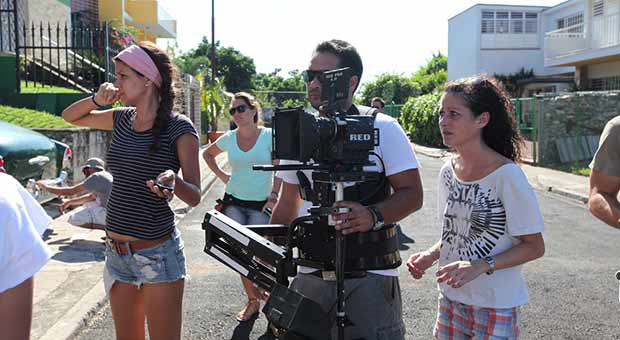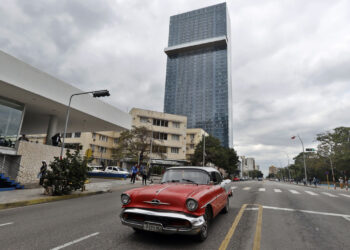I recall Jessica Rodríguez as a thin girl wearing a blue pre university uniform reciting nervously Cesar Vallejo´s poetry, her favorite. She used to walk with rapid steps in the hallways of the pre university school Vladimir I. Lenin chasing Lezama´s verses and running away from math. Today, we are almost 30 years old, and Jessica has gradually made come true the artistic dreams of our generation. Some of us lost their way, many others discovered new directions; but she, a teenager apprentice of artist, has become a Cuban and universal filmmaker. Some of her work, such as the documentary ‘Tacones Cercanos’, show in which she still keeps that inner feeling about her favorite poets, by Arthur Rimbaud.
EspejuelosOscuros (Dark glasses), her first full-length fiction film as director, inherits that concern of her own to explore the space reserved to women in the Cuban society and in the societies of the world.
This film, still in production, tells the story of four Cuban women from different epochs, who are interpreted by Laura de la Uz,and their possible relation with a man, Luis Alberto Garcia, always with society at the back. When Jessica was studying at the Audiovisual Faculty she wrote the script for this movie. The years went by and her career enriched her. She enrolled in a Master degree on cinematographic script; she produced several documentaries in Spain, Egypt, and Cuba… Quite recently she published her first novel La bestia y el pueblo (The beast and the people). However, despite the fact that she has become an artist of the world, Cuba and EspejuelosOscurosare still at the tip of her compass.
What elements allowed you to intertwine the four stories of the film in a common aesthetics?
I believe the most important element is the actors, they play the main characters of each story and that certainly transmits the idea of union. Even though, due to the change of epoch the art direction changes, we wanted to maintain similar visual elements in terms of aesthetic resources; photography by Susana Ojea, and editing by Miguel Burgos, part from the same formal schemein the four stories.
If you were to define your interests as producer, whether aesthetics, social or personal… Which would those be? What kind of projects would you like to undertake in the future?
When you do short documentaries you dream a lot; you have total formal freedom; you feel that you can take the risk because you don’t have anything to lose. When I sit to watch my work I think I recognize a common aesthetics: El mundo de Raul (Raul’s world), Ahlam and Crack! Search for detailed shots that take time and are joined by a voice in off. Another recurrent element in my short movies is the need to express moods from cinematographic resources, away from the information given in the dialogues. To me, it is very important to use all departments and resources of cinematographic language for the sake ofthe speech. Perhaps the character is telling you something with words but the visual image tells you the opposite.
Espejuelos Oscurosis a full-length fiction film probably less risky than my previous works in terms of how the story is told. As I was dealing with a new genre I tried to be as clear as possible and I intended to tell an enjoyable story without too many ambiguities. The film has several stages; you can just enjoy shallowly an entertaining argument that finds no difficulties but for the most restless spectators there are more complex issues behind each story.
AsI feel more comfortably as director I think I will be able to try other things I have in mind, but for now let’s just see if it works.
Do you think of yourself as a Cuban producer that contributes with the current and historic aesthetics or just a producer with likes and antecedents from anywhere in the world?
I think of me as a Cuban and a universal producer at the same time. Of course there is a Cuban language in everything I’ve made. I directed a documentary in Spain and one in Egypt: Crack! And Ahlam, but they both have things I learned in Cuba. To me it is really important that my work is known all over the world, El mundo de Raúl has participated in festivals in Asia, Europe, Africa, everywhere, and Crack! has taken part in more than 15 festivals in Europe, USA and Latin America but it is still as important that everything I do gets is premiered in Cuba because that´s the audience I care about the most. But my work isn’t for Cubans only, it is meant for everyone.
Tell me about the documentary you produced in Egypt? How was that possible?
The documentary was made from a script that won a subvention from AFAC (Association for Fostering Arab Culture), we shoot for two months in Alexandria and it has been almost a year and a half in postproduction, just now it is going to start its tour through festivals. “Ahlam” (a woman’s name that means dream in Arab) tells the story of an Egyptian girl of low class and her adventures during Arab springtime. Being a poor woman can be really difficult in a society where being a woman is already difficult.
¿And Crack!?
It is about two women not from different social classes but with different education. One is very conservative and catholic; while the other is very liberal and lived sexual liberation during the 60´s. These two women have had to face gender violence from entirely opposite perspectives. Crack! was present at the Young Producers Festival in Cuba, many colleagues saw it and gave me their opinion and I’m really pleased with their comments. This documentary tackles a difficult topic in a harsh manner so it is not an option to have a nice time at the cinema, humor there is really acid.
What was your motivation to produce El mundo de Raul?
I have suffered harassment ever since I can recall. What’s interesting in El mundo de Raul is that outside Cuba the phenomenon of public masturbation is barely known. It caught our attention that this is a common practice in Cuba, a place with such sexual openness. It is not a documentary about exhibitionism as a phenomenon, it is a work that intends to go deeper, and it deals with the personal oppressions of a man called Raul which takes him to masturbate in public.
EspejuelosOscuros is about four women in different epochs of the Cuban history.
It tells four stories. Esperanza (Laura de la Uz) is a blind woman that lives alone between two towns in Cuba today. Her loneliness is interrupted by the arrival of Mario (Luis Alberto García), a dangerous fugitive that is running away from two police officers. The man forces her to let him in, and Esperanza, just as Sherezada in the Arab Nights, starts telling him stories to try to keep him in line. And that’s how the other three stories intertwine with the main story. The other characters are also interpreted by Laura and Luis: Marlene’s story, during the fervent 70’s; Adela’s story, in the midst of the revolutionary movement, and finally Dulce’s story, framed during the Spanish-Cuban-North American war. Even though times change, we wanted to give the feeling that somehow the characters are intimately the same.










